Thin-film Polarizers
Acronym: TFP
Definition: optical polarizers based on a multilayer dielectric coating
German: Dünnschichtpolarisatoren
How to cite the article; suggest additional literature
Author: Dr. Rüdiger Paschotta
Thin-film polarizers are a kind of optical polarizers based on interference effects in a multilayer dielectric coating. That coating is usually placed on a glass plate. (A birefringent optical material as in various other types of polarizers is not needed.) A strongly polarization-dependent reflectivity is achieved for some range of incidence angles. (Basically always, s-polarized light is reflected and p-polarized light transmitted.) It is often convenient to design a thin-film polarizer such that it can be operated with an incidence angle of 45°, such that the reflected beam is obtained with an angular change of 90°.
There are different kinds of thin-film polarizers concerning optical fabrication technology and various properties which are of practical interest:
- Plate polarizers (Figure 1) consist only of a coated glass plate. The design is often made such that the angle of incidence is essential at Brewster's angle. In that way, reflection losses for the transmitted light on the back side are avoided easily. For other angles of incidence such as 45° (which is often convenient), an anti-reflection coating is required on the back side, and the layer structure design for the front side can also be more difficult.
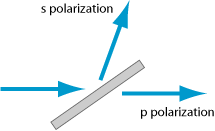
- There are also polarizing cubes (Figure 2), which are obtained by coating a 45° prism and cementing another 45° prism to it, so that a cube is obtained. The input and output faces usually obtain anti-reflection coatings. The basic idea of the common MacNeille cube design [2] is to eliminate the reflection for p polarization by having Brewster's angle at all internal interfaces. It is then easy to obtain high reflectivity for s polarization with a simple Bragg mirror design without introducing a significant reflection for p polarization. The Brewster angle condition requires that a substrate material with suitable refractive index (for given coating materials) is chosen. Such designs work well in a large range of wavelengths, but only in a narrow angular range (typically a few degrees).
In other polarizing cube designs than the MacNeille design, one does not fulfill the Brewster angle condition but uses interference effects to suppress reflection for p polarization. Such interference polarizers typically operate well only in narrow wavelength ranges but give more flexibility concerning the used materials.
The cemented interface of a polarizing cube leads to a lower optical damage threshold of the order of 1 J/cm2 for nanosecond laser pulses. Optically contacted epoxy-free polarizing cubes, not requiring a cement, can stand several times higher fluences.
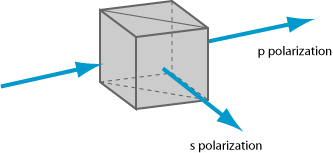
Since the interference effects in the multilayer coating are wavelength-dependent, a thin-film polarizer can work only in a limited wavelength range and angular range. However, operation in a range of tens or even a few hundred nanometers is possible by proper optimization of the thin film design. Such broadband polarizers, however, do not achieve the very high performance of narrowband polarizers (laser line polarizers), which are optimized for a narrow wavelength range. Figure 3 shows an example with a moderate operation bandwidth of 50 nm.
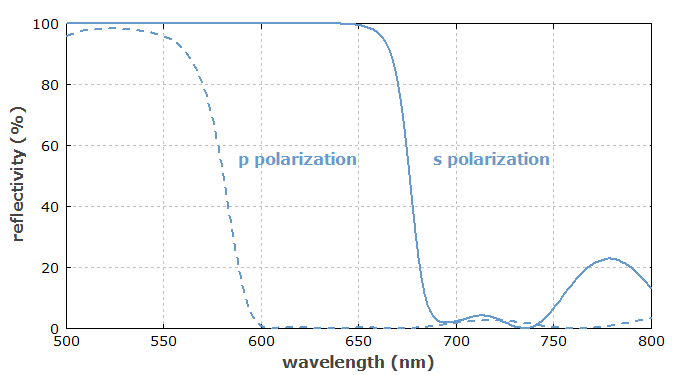
For the optimization of the coatings for thin-film polarizers, similar numerical techniques can be used as for designing broadband beam splitters or dichroic mirrors, for example.
An advantage of thin-film polarizers is that they can be made with rather large dimensions, which is more difficult with crystalline (birefringent) polarizers. It is thus possible to operate such high-power or high-energy devices with laser pulses at very high peak power levels.
Suppliers
The RP Photonics Buyer's Guide contains 34 suppliers for thin-film polarizers. Among them:

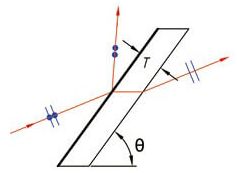
Artifex Engineering
Artifex Engineering offers custom dielectric thin-film polarizers with a high damage threshold. Our thin film polarizers are commonly used for Q-Switching and other high power applications. These components are dielectric coated glass substrates designed for use at the Brewster angle. Visit our product page for more information. We look forward to your inquiry.


Shanghai Optics
Shanghai Optics can provide all types of anti-reflective, high reflective, and partial reflective coatings. We produce a wide variety of coatings from a single layer of anti-reflective coating to complex multilayer dielectric stacks. Types of dielectric coatings are BBAR, V-coatings, dual wavelength coatings, and sharp cut-on and cut-off filters.

EKSMA OPTICS
Wide selection of BK7 and UV FS thin film laser polarizers for quick delivery. Thin film polarizers feature high laser damage threshold and are designed for the most demanding applications with Nd host lasers operating in the 1040–1070 nm range and with femtosecond Ti:sapphire or Yb:KGW/KYW lasers.


Laseroptik
LASEROPTIK offers various types of polarizers, including thin-film (TFP) devices, cube polarizers (CP) and broadband polarizers (BBPOL). We can work in different wavelength ranges from the mid-IR (2.1 μm) to the UV (157 nm).
Questions and Comments from Users
Here you can submit questions and comments. As far as they get accepted by the author, they will appear above this paragraph together with the author’s answer. The author will decide on acceptance based on certain criteria. Essentially, the issue must be of sufficiently broad interest.
Please do not enter personal data here; we would otherwise delete it soon. (See also our privacy declaration.) If you wish to receive personal feedback or consultancy from the author, please contact him e.g. via e-mail.
By submitting the information, you give your consent to the potential publication of your inputs on our website according to our rules. (If you later retract your consent, we will delete those inputs.) As your inputs are first reviewed by the author, they may be published with some delay.
Bibliography
| [1] | M. Banning, “Practical methods of making and using multilayer filters”, J. Opt. Sco. Am. 37 (10), 792 (1947), doi:10.1364/JOSA.37.000792 |
| [2] | S. M. MacNeille, “Beam Splitter”, U.S. Patent 2,403,731 (9 July 1946) |
| [3] | J. Mouchart et al., “Modified MacNeille cube polarizer for a wide angular field”, Appl. Opt. 28 (14), 2847 (1989), doi:10.1364/AO.28.002847 |
| [4] | Design of a thin-film plate polarizer with the RP Coating software |
| [5] | Design of a polarizing cube with the RP Coating software |
See also: polarizers, dielectric coatings
and other articles in the category general optics
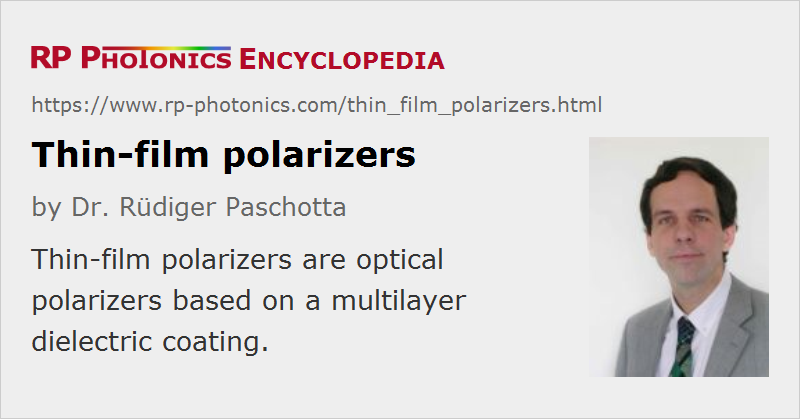 |




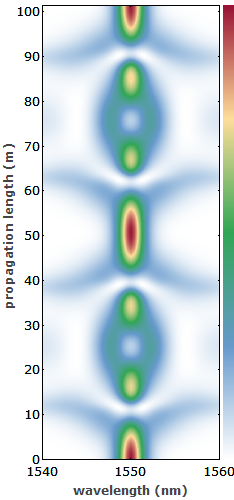


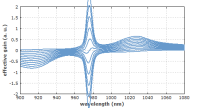
If you like this page, please share the link with your friends and colleagues, e.g. via social media:
These sharing buttons are implemented in a privacy-friendly way!